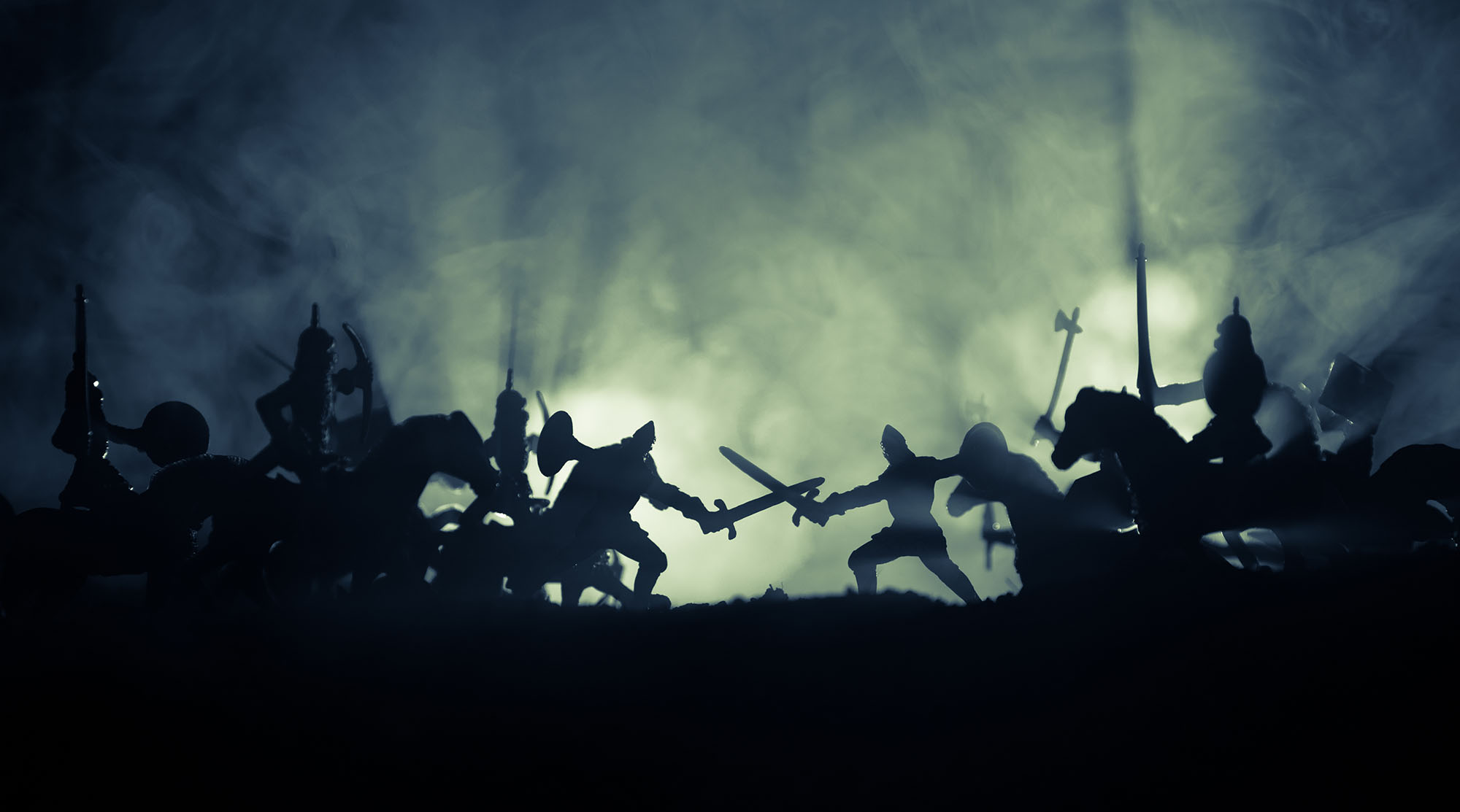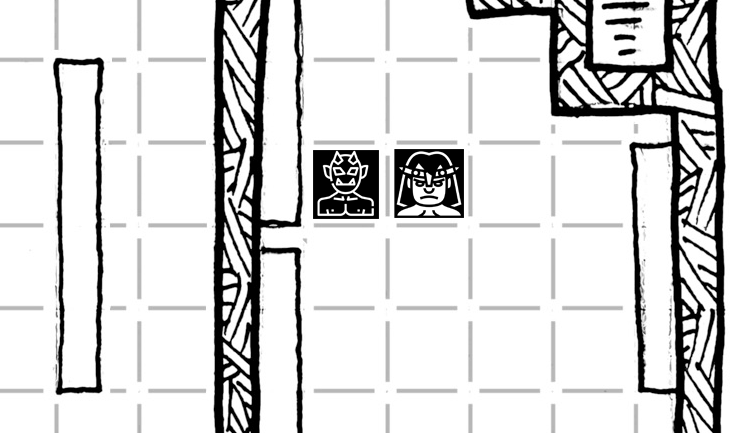
Combat is ubiquitous in tabletop roleplaying games. A little bit because the modern RPG evolved out of wargames; a little more because combat is mainstay genre element in the pulp fiction and procedurals that underlie most RPGs; but mostly because simulated combat is fun!
As a GM, therefore, a lot of your time will be spent running and describing combat scenes. To do that successfully, you’ll first need to visualize the battlefield. Only when you can truly see what’s happening will you be able to evoke it for your players.
ON THE BATTLEMAP
Part of this, of course, is keeping your vision of the battle clear and consistent. If the continuity of the game world is constantly morphing without rhyme or reason, it will undermine everything you’re trying to accomplish.
One way to objectively achieve this consistency is through the use of a battlemap, particularly in combination with rules that are designed to take advantage of the battlemap’s precision. When everyone at the table can clearly see the map of the battlefield and where everyone is located on that map, it’s trivial for everyone to stay on the same page.
When using a battlemap, however, it’s also easy to suffer from grid rigidity: Your mental picture of the battle gets locked into the physical, unmoving miniatures on the battlemap. This results in static, boring descriptions of combat in which the goblin is standing in their 5-foot-square and the barbarian is standing in their 5-foot-square and the two of them stand there, swinging swords back and forth.
To escape from grid rigidity in your descriptions, the first thing to realize is that characters are not simply standing in the middle of their square. Part of the abstraction of the grid is that you are SOMEWHERE inside the square, but we don’t know where. There’s even times when you’re “actually” in a neighboring square (because, for example, you’re punching someone in the face who’s “in” that square).
A miniature’s grid position on the battlemap is best understood as an approximation of the character’s location. You can almost think of it as a quantum superposition, where the character’s specific location and action only becomes certain when it is “measured” by description.
Once you’ve internalized this reality that the map is not the territory, you’ll be freed up to describe dynamic, active interactions on the battlefield. For example, let’s consider our goblin and barbarian once again:

If we imagine these characters standing in the middle of their squares and exchanging blows, we might say something like, “Athargeon lifts his two-handled blade high above his head and swings it down! The goblin tries to squirm out of the way, but isn’t quick enough. It’s gutted from shoulder to nave.”
And that’s cool enough. Nothing wrong with it.
But if we can escape grid rigidity, then we’re freed to introduce descriptions like this: “Athargeon dashes forward. His two-handed blade plunges through the goblin’s belly, driving it back into the bookshelf behind it. A shelf shatters and crystal balls fall from the ruin, splintering to pieces on the stone floor. The goblin scrabbles at the blade pinioning it to the wall, knocking more books to the ground, before giving a final bloody gasp.”
The mechanical resolution here is the same in both cases (Athargeon rolls a successful hit and deals enough damage to kill the goblin), but note in the latter description how the characters are now dynamically moving through the space and interacting with the environment.
Athargeon can’t drive the goblin back and the goblin can’t smash into the bookcase if they’re both stuck in the middle of their squares with their feet figuratively glued to the floor.
THEATRE OF THE MIND
If you’re not using a battlemap, of course, then grid rigidity isn’t a problem. But without the reference of the battlemap, you’ll need to keep track of the entire battlefield and everyone on it in your head.
With a little practice, this isn’t too difficult to achieve if you’re only dealing with a handful of combatants. It’s also possible to “cheat” a little by doodling a little sketch for yourself (and/or your players) to help keep things straight.
But as the number of combatants grows, this will become more and more difficult. You’ll start making mistakes, confusing your players and leading to a frustrating and unsatisfying experience. The other problem I have is that the more of my brain is tied up trying to keep the continuity straight, the less focus and creativity I can give to providing vivid descriptions of the fight! Ironically, the more epic a confrontation becomes in terms of scale, the more pedestrian its execution threatens to be as we all get tied up in the logistics of what’s happening.
What I’ve found useful is to think in terms of melees and battle lines.
A conceptual melee basically takes a group of combatants and says, “You’re all fighting with each other.” Anyone in a melee is assumed to be able to attack anyone else in that melee as the chaotic swirl of combat brings characters within reach of each other.
For example, a fight might break down into a “big melee in the middle of the room” between the fighter, the paladin, and a half dozen goblins, while the wizard and cleric are holding back outside the melee. But you might also have a fight with multiple melees: There’s a cluster of characters fighting at the top of the stairs and another cluster of characters fighting at the bottom of the stairs while the rogue, who isn’t in a melee, is swinging on the chandelier.
The point, obviously, is to conceptually simplify how many variables we’re keeping track of. We don’t need to keep track of exactly where the fighter, the paladin, and the half dozen goblins are in relation to each other; we just need to know where they ALL are in relation to the rest of the fight.
A melee should not, however, be used as an excuse for your descriptions of the fight to become muddy or generic. This can be an easy trap to fall into, but just as abstracting the goblin’s position to being “in that 5-foot-square” shouldn’t preclude us from describing him getting slammed into the bookcase, so abstracting the goblin’s position as being “in that melee” shouldn’t preclude vivid, specific description.
In fact, the flexibility of the conceptual melee can actually free both you and your players to greater heights of creativity in the actions you take and how you describe them.
There are limitations to the utility of the melee, however: situations in which the abstraction of the melee is either not useful or confusing. The solution, of course, is to simply not use melees in those situations.
(It feels like it should be more complicated than that, but it isn’t: Just Don’t Do It.)
One common case where melees aren’t useful is the formation of a battle line. In my experience, this most commonly happens in the tight quarters of a dungeon: In order to protect the squishy spellcasters, the melee-types form a line across the dungeon corridor to block the bad guys. If the party is large enough, you may see the formation of a second line with reach weapons.
Meanwhile, on the other side, the bad guys usually outnumber the good guys, so they’ll funnel in, forming an opposing line.
What I generally find useful at this point is to simply write out the line from left to right:
Athargeon Edvinas Nazli
Goblin 1 Orc Goblin 2
Jotting this down only takes a couple of seconds and can be done as the players declare their intention to form the line. Generally characters can attack anyone directly in front of them, or immediately to their left or right. (So in the above battle lines, for example, Athargeon could attack Goblin 1 or the Orc, while Edvinas could attack anyone in the opposing line.)
What you may realize is that you’ve effectively created a tiny two-by-three grid, just like the one you would see on a battlemap. In order to respect the tactical intention of the characters (to form a defensive line), this shouldn’t be handled as a conceptual melee. The relative positions of these characters should be locked in, just like they would be on a grid.
There will now be a temptation to really lock into the imagery of these two static lines exchanging blows back and forth. And there can be a lot of good material to work with in that.
But you’ll also want to be aware that this can easily loop back once more to grid rigidity: Bring the environment into your description. Let people take dynamic actions within the line. Explore the verticality of the line. Have the line ebb and flow. You can even threaten the integrity of the line, with enemies threatening to overwhelm or break through it.
PRACTICE, PRACTICE, PRACTICE
All of this, of course, ultimately boils down to what the characters are actually doing during the battle. It’s easy enough to say that there should be a cool finishing move when a PC kills an NPC or that you should incorporate the environment into your descriptions, but it’s ultimately up to you to look at the barbarian, the sword, the goblin, and the bookcase, and then put those together into something awesome.
And that’s more art than science.
But it IS something that can be practiced.
The most straightforward way to practice, of course, is to simply run more combats: Schedule more sessions and play, play, play, play.
But you can also practice between sessions. One exercise I’ve found useful is to watch a really great fight film — John Wick or 300 or Fellowship of the Ring or Police Story — and simply narrate the action as it happens on the screen, as if you were describing it your gaming group.
This exercise will build your repertoire of fight moves, develop the vocabulary you have for describing a fight, and even teach you a little bit about the effective pacing of fight sequences (although the pacing of an RPG fight will usually be distinctly different from that of a film).
You’ll be able to take those skills and use them to fuel your visualization of the battlefield.
Creative Commons Icons: Goblin by Linector, Barbarian by Delapouite.
Cartography by Dyson Logos.












Very useful! I struggled with combats in my early free-kriegspiel games, eventually developing a simple but constricting grid-map ruleset of my own (“You can move five spaces, the goblins can move six.”) The concept of moving through the “battle space” to use the environment is especially helpful, and I will keep it in mind going forward.
Two games that handle this fairy well are Fate and The One Ring. Fate divides combats up into zones, which are rough areas of the map. If you’re in a zone, you can fight everyone else in the same zone, otherwise you’ll have to move. The One Ring separates the teams into different battlefield stances: Forward (easiest to hit but also be hit), Open (melee), Defensive (harder to hit but also harder to hit others), and Rearward (ranged attacks). The system breaks down a bit if you attempt a more freeform combat rather than structured, but the basic system provides a middle ground between pure TotM and grid combat.
The link is broken when you say “a lot of good material” above
I think YouTube took whatever movie you were referencing down. What was it I wonder?!
Fairly certain it was a clip from the movie 300.